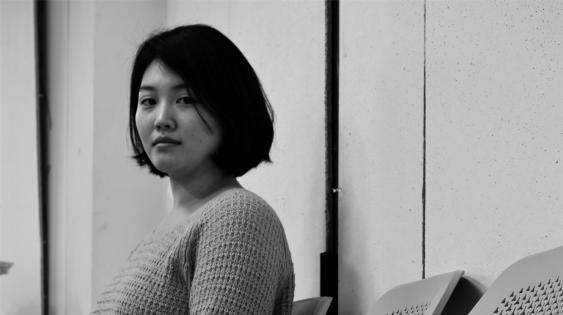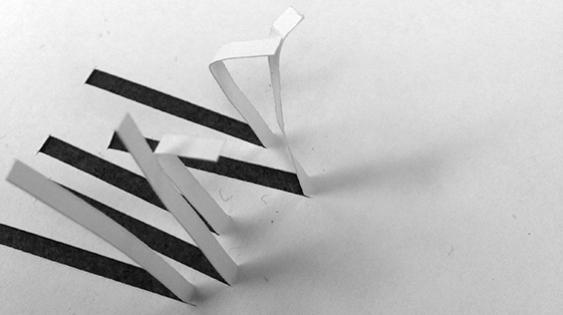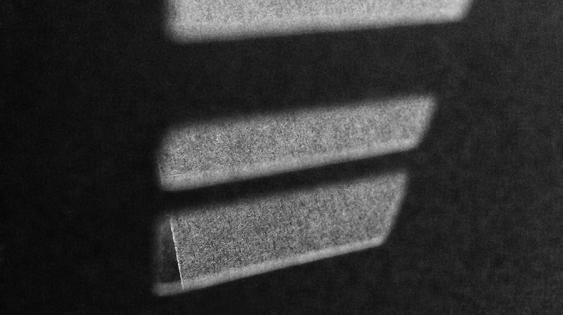UIC: Kay, what is your masters topic?
Hong: The absence and presence of sound.
What made you decide to focus on this particular topic?
When studying art history at SUNY Buffalo, I was very interested in the way female artists use their body as a canvas to claim authority and authorship, and I was interested in the ways that these ideas might be translated into graphic design. I wasn’t quite sure how to develop this topic, which emerged from my undergraduate education, into a master’s thesis, and I didn’t feel that the topic was my own. I also have a strong interest in typography. While brainstorming, I wondered if there was anything from my Korean background that could help to focus my ideas.
I looked at the way the shapes of Korean alphabets are linked to the phonemes they represent. The shape of Korean characters are representations of pronunciation—they are shaped by how they sound. This idea is about type and it has a connection to the body. Sound is the overlapping area of my past interest in the body and my interest in typography.
Why was this topic’s exploration important to you?
Sound represents a common area between my interests in type and the body. I also value design that looks carefully at human experience and that stimulates the viewer’s senses. I believe that attention to sensory factors makes graphic design powerful. Given the visual nature of the field, it might seem unusual to incorporate sound or hearing into graphic design. Yet the more I researched, the more I discovered that a very strong relationship exists between sound and hearing. What we see is often what we hear, or what we hear is often what we see.
What was the most difficult part of your masters exploration?
In one of our studio classes, we designed posters for the Ravinia Music Festival. I was also aware of a former graduate student whose thesis investigated the visualization of music. Knowing and seeing these other visualizations of music and sound, I wanted to go in a direction that was different. When writing my paper, I wanted to propose a path that looks carefully at the human experience of sound, and a path that moves away from designing based on oscillographs or sound waves. I was concerned, though, that it might make my explorations in the coming semesters too narrow, so I ended my research by investigating broader possibilities. While I was writing my paper I left the ending open; later when designing my book, I looked back at the idea of moving away from oscillographs and sound waves, and focussed on the absence and presence of sound. Again, when designing my book, translating this idea into visual form was difficult. I had to think of different types of silence: absolute silence, subtle silence, intense silence, and so on.
Did you learn any important lessons over the course of the project?
Yes: how to develop a topic, how to dig in deep, and how to research visually. I’ve also learned to take a step back and consider the experience of the viewers/users and ask myself: “How would a reader follow my book? What pace is easy/difficult/awkward? Is the transition noticeable for readers? Is this moving image easy for viewers to follow? What is the best format for making viewers more sensitive to the link between visual and auditory experience? And so on.
What did you learn at UIC that you didn’t in college?
I enjoyed my experience at Buffalo and learned a lot during my undergraduate studies. Perhaps because the major was called “Visual Communication” or perhaps because it was part of the Visual Studies department, we learned basics in a very short time and were then pushed to think in experimental ways, using different materials, to represent different ideas, and so on. UIC helped me learn to see and pushed me to further investigate the foundations of graphic design: typography and composition. UIC also helped me value process, and pushed me to develop my own thoughts and opinions about design.
What do you like about the MDes program?
I enjoy the process, the steps that go from writing, to designing a book, to designing a project. I also like the way some of the studio classes connected to my thesis work. Sharon’s class prepared me to discuss and visualize my thesis topic; Cheryl’s documentation class prepared me to design my masters book.
What do you see yourself doing after graduating from the program?
I’m not quite sure. I enjoy teaching and that is something I would love to do in the future. But before teaching, I would like to have more work experience.
What advice would you give incoming students when they join the program?
Be passionate. Try to enjoy every step. Have fun with your classmates. They are the ones who will be there for you, encourage you, and understand all the struggles you are going through in graduate school.
Is there a memorable experience from UIC that you experienced that you’d like to share with others?
All the fun memories with my classmates here in Chicago and in Basel. When going through hard times, classmates and teachers were encouraging.
Was there an experience in the MDES program that you didn’t expect?
Getting a sneak peek of an Art Institute exhibition installation during Zoë Ryan’s class.
What did you expect from the program?
Networking with Chicago designers. Building relationships with faculty. Field trips.
When you pursued your masters project, what did you expect? What didn’t you expect?
I’m not quite sure what I expected when pursuing my thesis. The program encouraged me to start like a blank piece of paper, without expectations—if I had a preconceived idea of what my writing or design would be in the end, it would be difficult for me to escape that and truly explore.














